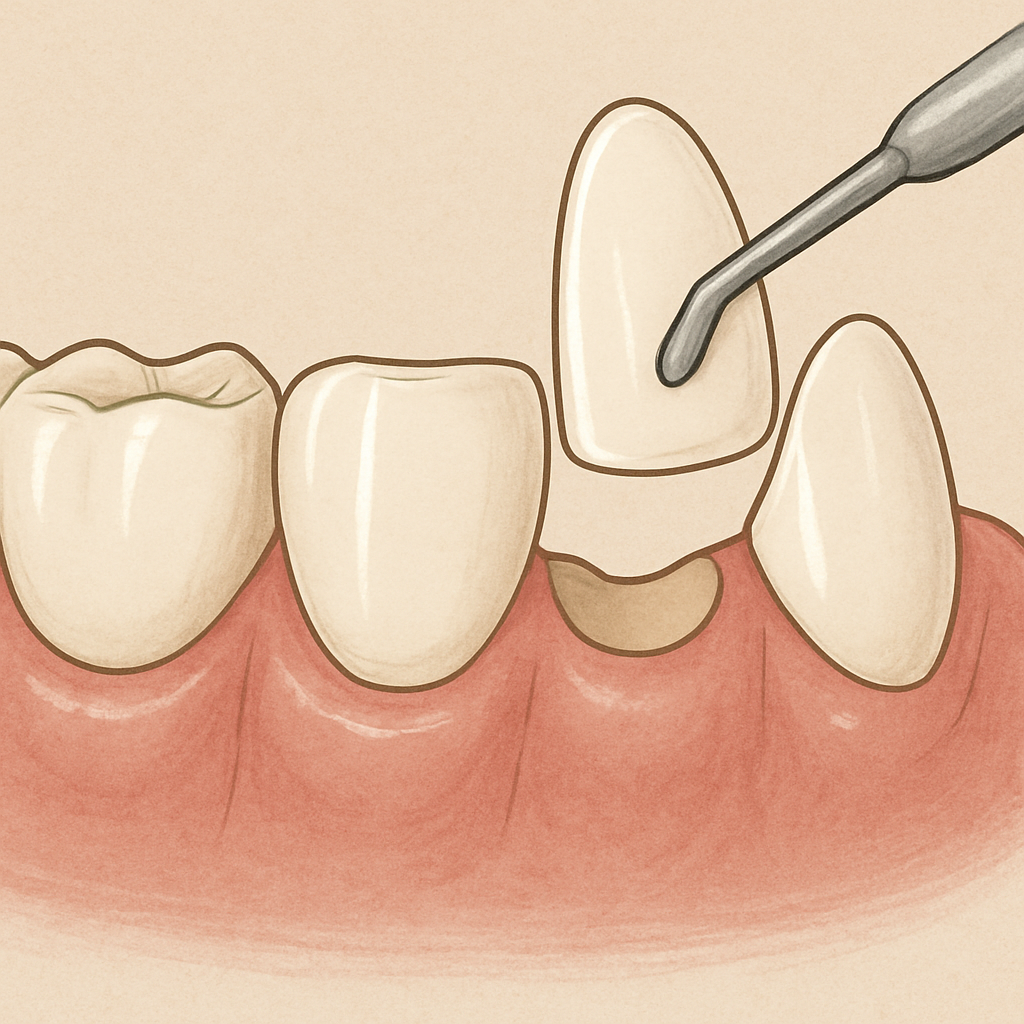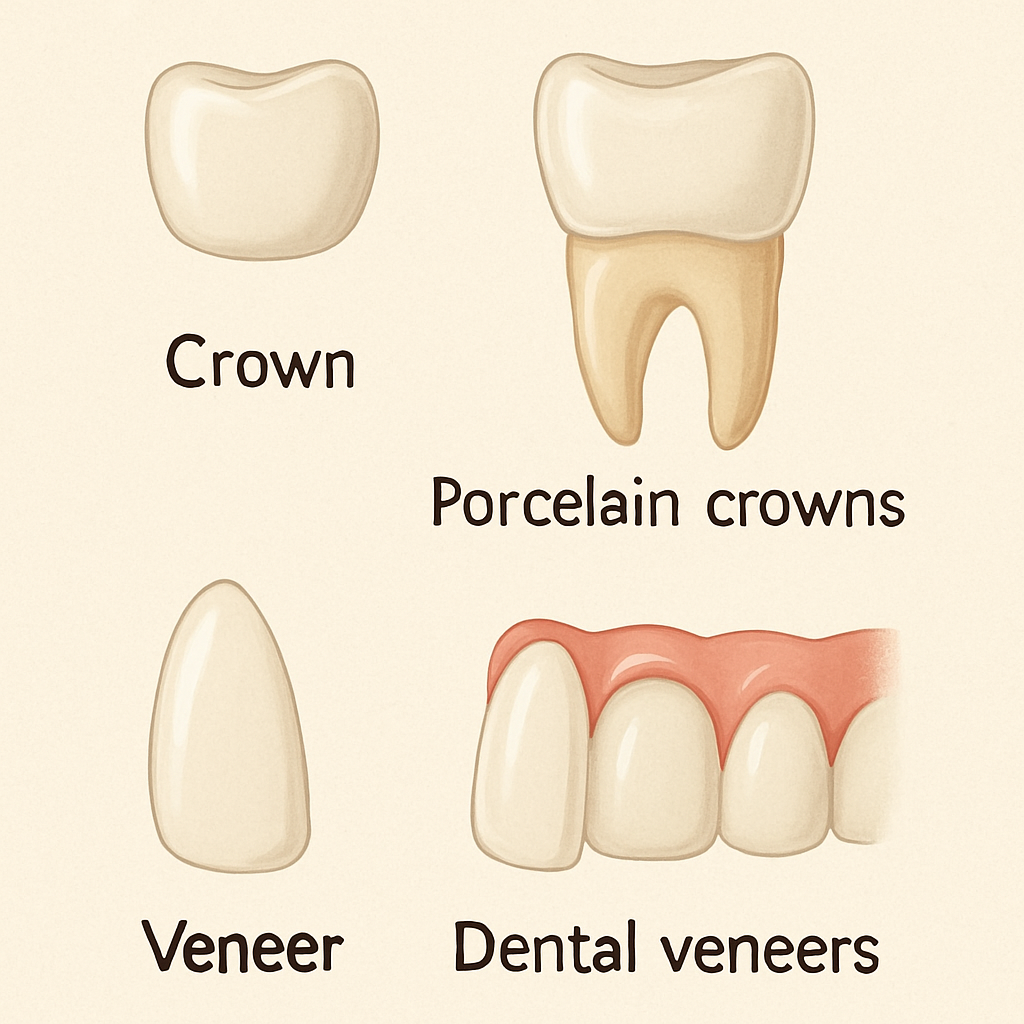Porcelain crowns and dental veneers are popular choices in cosmetic dentistry. They both enhance the look of your teeth. But how do they differ?
Understanding these differences is crucial for making informed dental decisions. Porcelain crowns cover the entire tooth, offering strength and protection. Veneers, on the other hand, are thin shells placed on the front of teeth.
Each option has its unique benefits and applications. Knowing which is right for you depends on your dental needs and goals. Let’s explore the key differences between porcelain crowns and veneers.

Understanding Porcelain Crowns and Dental Veneers
Porcelain crowns and dental veneers both play significant roles in cosmetic dentistry. They help improve the appearance and function of teeth, but each serves a different purpose. Let’s look deeper into what sets them apart.
Porcelain Crowns:
- Cover the entire tooth.
- Provide strength and protection.
- Ideal for damaged or decayed teeth.
Dental Veneers:
- Thin shells covering the tooth’s front.
- Focus on aesthetic enhancements.
- Address minor imperfections like discoloration and chips.
These dental solutions are tailored to meet specific needs, enhancing both form and function. The choice between them hinges on the tooth’s condition and the desired outcome. Consulting with an expert helps in determining the most suitable option. You’ll gain insights tailored to your unique dental profile.
What Are Porcelain Crowns?
Porcelain crowns are a popular choice in dental restoration. These crowns cover the entire surface of a tooth, providing both protection and aesthetic appeal. They are often used for teeth that have suffered significant damage or decay.
The application of porcelain crowns involves removing part of the tooth to fit the crown snugly. This ensures durability and a natural look. It mimics the natural shape and size of teeth, aiding in functions such as chewing and speaking.
Porcelain crowns are preferred for their strength and ability to blend in with existing teeth. They are particularly suitable for:
- Root-canal-treated teeth
- Teeth with large fillings
- Severely decayed or damaged teeth
Given their robust design, porcelain crowns offer long-term solutions with proper care and maintenance. They not only restore function but also enhance smile aesthetics. The seamless integration with natural teeth is a key feature.
What Are Dental Veneers?
Dental veneers are thin shells made to enhance the appearance of teeth. They are bonded to the front of the teeth to address cosmetic concerns. Individuals with minor imperfections like stains, chips, or small gaps often choose veneers.
The application of veneers requires minimal tooth preparation. This process involves gently reshaping the surface of the teeth to fit the veneer. The aim is to preserve as much of the natural tooth as possible while achieving the desired appearance.
Veneers are sought after for their ability to dramatically improve smile aesthetics. They offer a quick solution for those wanting significant visual changes without extensive procedures. Common issues veneers address include:
- Discoloration or staining
- Minor chips or cracks
- Uneven or misaligned teeth
These veneers provide a natural-looking outcome, enhancing both beauty and confidence. They are popular in smile makeovers for their immediate and noticeable results.
Porcelain Crowns vs Veneers: Key Differences
Porcelain crowns and dental veneers serve different purposes in dentistry. Crowns cover the entire tooth, providing protection and strength. They are ideal for teeth that are damaged or have undergone a root canal.
Veneers, in contrast, cover only the front surface of the tooth. They are primarily used for aesthetic purposes to address cosmetic concerns. While both solutions enhance smiles, their functions and applications differ significantly.
When considering durability, porcelain crowns tend to be the stronger option. They are designed to withstand forceful biting and chewing, making them suitable for molars. Veneers are more delicate and typically recommended for front teeth.
The preparation of teeth for these treatments also varies. Crowns require more tooth reduction compared to veneers. This means more of the natural tooth is filed down to fit the crown snugly.
Patients may choose between them based on personal needs and dental health. It’s crucial to weigh the benefits and limitations of each before deciding.
Key differences include:
- Coverage: entire tooth vs. front surface
- Durability: crowns are stronger
- Application: crowns for damaged teeth, veneers for aesthetics
- Tooth preparation: more reduction for crowns
Procedure: How Are Porcelain Crowns and Veneers Applied?
The procedures for porcelain crowns and veneers require meticulous dental work. However, each involves distinct steps tailored to the treatment.
For porcelain crowns, the process begins with reshaping the tooth. A precise amount of the tooth structure is removed to make space for the crown. Next, your dentist will take an impression of the prepared tooth to craft a custom crown.
In contrast, veneers require less tooth alteration. Your dentist lightly buffs the front surface of the tooth to ensure a proper fit for the veneer. Like crowns, a mold is taken and sent to a lab for veneer fabrication.
Both procedures typically involve temporary fittings while waiting for the final product. Once the crown or veneer is ready, it’s securely bonded to the tooth.
These steps ensure long-lasting results:
- Tooth preparation
- Impressions for customization
- Temporary fittings
- Permanent bonding
Durability and Longevity: Which Lasts Longer?
When it comes to durability, porcelain crowns tend to outlast veneers. Crowns can endure significant pressure and often serve for over 15 years when well maintained. They offer robust protection, especially for teeth that have undergone substantial work like root canals.
Veneers typically last between 7 to 15 years. They are durable but can be prone to chipping if care is not taken. Regular dental check-ups help in maintaining their longevity and appearance.
Both options require dedicated oral hygiene to extend their lifespan. Key practices include:
- Consistent brushing and flossing
- Avoiding hard foods and habits
- Regular professional cleanings
Aesthetics and Natural Appearance
Porcelain crowns and veneers both excel in aesthetic appeal. They are designed to mimic the look of natural teeth. Both options can be color-matched to blend seamlessly with your existing teeth, ensuring a uniform smile.
Veneers are particularly known for providing a naturally beautiful appearance. They offer a less invasive way to enhance the aesthetics of front teeth. Meanwhile, crowns can improve the look of both front and back teeth, making them versatile.
Here’s why they are popular for cosmetic improvements:
- Natural tooth-like translucency
- Customized shape and size
- Seamless color integration
Cost Comparison: Porcelain Crowns vs Veneers
The cost difference between porcelain crowns and veneers can be significant. Crowns are typically more costly due to the procedure’s complexity. This includes more extensive tooth preparation and materials used.
Veneers generally cost less, as they involve only the front surface of the tooth. They’re often considered a cosmetic procedure, which might not be covered by insurance. It’s important to check with your provider.
Here are some financial considerations:
- Crowns often covered if medically necessary
- Veneers less likely to be insurance-covered
- Discuss costs with your dentist beforehand
Maintenance and Aftercare
Proper maintenance is crucial for both porcelain crowns and veneers. Good oral hygiene prolongs their lifespan. Regular brushing and flossing are essential to prevent plaque buildup.
Seeing your dentist for routine checkups is equally important. This helps catch potential issues early and maintain oral health. It also ensures professional cleaning.
Here are some aftercare tips:
- Avoid biting hard objects like ice or pens
- Use a non-abrasive toothpaste to prevent surface damage
- Wear a mouthguard if you grind your teeth at night
These practices support longevity and appearance.
Pros and Cons of Porcelain Crowns
Porcelain crowns offer several advantages. They are durable and provide excellent protection for damaged teeth. These crowns can also improve tooth function and appearance.
However, there are some downsides. Porcelain crowns involve more extensive tooth preparation. They are also more costly compared to other options.
Pros:
- Durable and long-lasting
- Natural-looking
- Strengthens and protects teeth
Cons:
- Requires significant tooth reduction
- Higher cost
Pros and Cons of Dental Veneers
Dental veneers are excellent for enhancing smile aesthetics. They require minimal tooth reduction and provide a natural look.
Yet, veneers are more prone to chipping compared to crowns. They are also generally considered cosmetic, so insurance may not cover them.
Pros:
- Minimal tooth preparation
- Natural appearance
- Effective for cosmetic improvements
Cons:
- Prone to chipping
- Not usually covered by insurance
How to Choose: Which Option Is Right for You?
Deciding between porcelain crowns and veneers requires careful thought. Your dental needs and aesthetic goals play a crucial role in the decision.
Consulting with a dentist is vital to determine the most suitable option. They will assess your oral health and guide you through choices.
Consider factors such as durability, cost, and desired appearance. Personal preferences and lifestyle habits should also influence your decision.
Considerations for Choosing:
- Condition of your teeth
- Aesthetic goals
- Budgetary constraints
Frequently Asked Questions
Are porcelain crowns and veneers the same?
No, they serve different purposes in dentistry. Crowns cover the entire tooth, while veneers only cover the front.
How long do they last?
Porcelain crowns can last over 15 years. Veneers usually last between 7 to 15 years with proper care.
Do both require anesthesia?
Yes, both procedures typically involve local anesthesia for patient comfort during preparation.
What about insurance coverage?
Insurance often covers crowns if medically necessary. Veneers may not be covered as they’re considered cosmetic.
FAQs Summary:
- Lifespan: Crowns last longer than veneers
- Anesthesia: Required for both procedures
- Insurance: Crowns more likely covered than veneers
Conclusion: Making an Informed Decision
Choosing between porcelain crowns and veneers requires a clear understanding of your dental needs. Both options offer unique benefits and contribute to a beautiful smile.
Consulting with a dental professional is crucial to make the best choice. They can provide insights based on your dental health and aesthetic goals. Proper guidance will ensure that your decision enhances both the function and appearance of your teeth.







